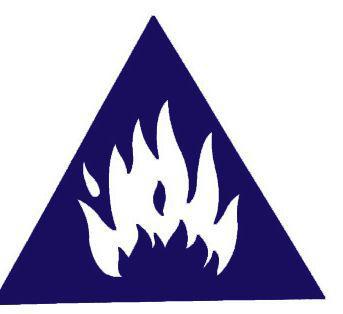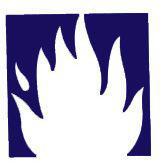SAS Urban Survival Handbook (53 page)
Read SAS Urban Survival Handbook Online
Authors: John Wiseman
Tags: #Health & Fitness, #Reference, #Survival, #Fiction, #Safety, #Self-Help, #Personal & Practical Guides, #General, #Survival Skills

At work the risks are just as great, no matter whether you work in known hazardous conditions or in the most up-to-date office block. However, one advantage of living in the city is the short response time of fire brigades—although you cannot rely on that as your only safeguard.
To reduce the risks, to protect yourself and possibly save lives you MUST understand more about fire—how it can start, how it behaves and how it kills.
KNOW THE ENEMY!
Fire is a chemical reaction—but it’s easy to forget what can make that reaction happen. If you were starting a fire in a grate or on a barbecue, you would need kindling or firelighters on to which you would put coal, wood or charcoal. This is your
FUEL
. A lighted match is the first source of energy or
HEAT
. The fuel might not burn easily, so you blow on the firelighter or fan it. By doing so, you are providing the third vital ingredient,
OXYGEN
. If there is a good supply of oxygen the firelighter will burn freely and generate more heat and the fuel will start to burn, result—
FIRE
.
THE FIRE TRIANGLE
 The three ingredients can be remembered as the fire TRIANGLE. The scientific term for the chemical reaction is oxidation or combustion. The fire will continue to burn, as long as the three ingredients—the points of the fire triangle—are present. If one of the points of the triangle is removed, it will collapse—the fire will go out.
The three ingredients can be remembered as the fire TRIANGLE. The scientific term for the chemical reaction is oxidation or combustion. The fire will continue to burn, as long as the three ingredients—the points of the fire triangle—are present. If one of the points of the triangle is removed, it will collapse—the fire will go out.
REMEMBER
The fire triangle idea should be applied to any location or situation you find yourself in. Fire prevention means identifying, in advance, where the three points—HEAT/FUEL/OXYGEN—are going to come together with possibly deadly results.
Breaking the triangle
Whether you are snuffing a candle or putting out a house fire, your intention is the same—deprive the fire of at least one of the three points of the fire triangle. This can be done by removing:
- ◑
FUEL
Fire breaks (wide channels with no trees) in forests do this. A forest fire will spread only as far as the fire break—it can go no further because there is nothing to burn. In the urban environment or in your home ‘fuel’ is everywhere! - ◑
HEAT
Water is the classic way to cool a fire—with a hose or a bucket. - ◑
OXYGEN
Literally suffocating the fire. This is almost impossible outdoors, but it is the key to stopping or slowing down fires inside. On a small scale, this is how a fire blanket works.

WARNING
The speed at which a fire can spread is something that should never be underestimated! Using evidence from fires in homes and public buildings, fire experts have established that even a large building or structure can be totally engulfed by flames WITHIN TWO MINUTES.
Man-made structures like houses are built from and contain large quantities of fuel. Most of our possessions and furniture are highly combustible. They are made either of natural products such as wood, or man-made materials – many of which contain highly-poisonous and highly-flammable chemicals. Most parts of a building are well ventilated. Large windows, doors, corridors and ventilation systems provide a ready supply of oxygen.
If the third ingredient (heat) is provided under these circumstances, a fire of extreme intensity can be created in a frighteningly short space of time. You may have only two minutes to make sure all the occupants of your home are safe.
How fire spreads
When a building fire starts it spreads rapidly, heating up its surroundings by:
- ◑
DIRECT CONTACT
Flames passing from one object to another. - ◑
CONVECTION
Heat rising, carrying gases and smoke. - ◑
RADIATION
Heat rays causing flammable objects in the vicinity to burst into flames.
Convection is the most life-threatening, as it is the fastest way the smoke and flames travel—a fire spreads rapidly UP a building. This is why stairwells are so dangerous.
FIRE IN THE HOME
 Almost 90 per cent of fires in the home can be traced to one of ten causes. Here they are, in order of importance, starting with the most common:
Almost 90 per cent of fires in the home can be traced to one of ten causes. Here they are, in order of importance, starting with the most common:
COOKERS The largest single cause of domestic fires. Fat fires, especially those caused by chip pans, frequently get out of control.
PORTABLE HEATERS Knocked over accidentally or left too close to furniture or flammable materials, the main culprits are electric, cylinder gas and paraffin (kerosene) heaters.
CIGARETTES Each cigarette is a potential fire-starting heat source. Accidentallydropped cigarettes fall on to upholstered furniture or beds, smoulder for a while and then flare up.
MATCHES Left either too close to fires or within reach of young children.
ELECTRICAL WIRING Old or badly-installed wiring, incorrect fuses and overloaded sockets generate heat that starts fires.
ELECTRIC BLANKETS Old blankets develop faults, often because they have been folded up too tightly. The element inside breaks or becomes exposed – when plugged in, it short circuits and catches fire.
BLOW TORCHES/LAMPS Used for ‘do it yourself’ and by professionals, they start fires when they are used carelessly, are left unattended or are not maintained properly.
TELEVISIONS/COMPUTER SCREENS These operate using very high voltages – far higher than other domestic appliances – and electrical faults cause fires and explosions.
CHIMNEYS Neglected for too long, soot builds up and catches fire – sometimes undetected until serious structural damage has been done.
CANDLES A simple unguarded flame – easily knocked over and capable of igniting furniture and fittings in seconds. Forgotten or neglected candles may produce disastrous results.
FIRE AT WORK
 In industry, flammable materials such as chemicals, fuels and gases MUST be stored according to specific fire safety regulations. They should ALWAYS be stored away from sources of heat and heat-generating processes like machining, smelting and firing. They should also be kept apart from each other—avoiding the formation of deadly ‘cocktails’ in the event of fire.
In industry, flammable materials such as chemicals, fuels and gases MUST be stored according to specific fire safety regulations. They should ALWAYS be stored away from sources of heat and heat-generating processes like machining, smelting and firing. They should also be kept apart from each other—avoiding the formation of deadly ‘cocktails’ in the event of fire.
Full training should be given to minimize accidents, although human error is only one factor. A faulty piece of machinery or badly-maintained plant could easily be a cause of fire.
In an office there may not seem to be as many obvious fire risks as there are in a factory. Nevertheless, offices contain all the ingredients that can lead to serious fires. Furnishings, equipment and stored paper are found in abundance. Old buildings could have faulty wiring or poorly-maintained electrical fittings. Electrical equipment and wiring could, in the event of a malfunction, be the heat source that starts a fire.
MODERN BUILDINGS
In large modern offices, particularly those which rely heavily on computers, there is a different set of fire hazards – providing architects and office designers with major problems. These offices consume a large amount of electricity and are served by complicated wiring systems. At the same time the environmental temperature must be controlled by air conditioning for higher efficiency and comfort.
Accommodating both wiring and air conditioning, but keeping them out of sight, means that many offices are designed with false ceilings and cavity floors. In most cases these meet fire safety requirements. In the event of a fault developing (modem dockside office developments in London, for example, are plagued by mice and rats which can chew through wiring) a fire could start undetected, in close proximity to good ventilation from air conditioning. Even a reinforced concrete structure can burn!
PUBLIC BUILDINGS
Fire experts have identified two categories of public building which give rise to the greatest concern: sports grounds and large shopping premises.
The safety of sports grounds depends largely on their design and construction. Football stadium fires in the past have served as tragic lessons in how not to build such structures. Wooden seats, stands or roofs are obviously dangerous. The build-up of discarded rubbish which needs only a carelesslythrown cigarette to spark a fire greatly adds to the danger. The difficulty of evacuating large crowds in a very short space of time is often the main reason for high death tolls.
In a shop, fire could be started by any of the causes mentioned already but two factors make the outbreak of fire even more hazardous. Shops may contain large quantities of combustible materials, and they often have complex layouts (and the casual shopper is unlikely to be aware of fire exits). These factors, particularly if the shop is crowded, will make the staff’s job of evacuating panicking shoppers extremely difficult.
The open plan design of many shops means that fire and smoke can spread easily. In an environment designed to encourage the free flow of shoppers, it is difficult to restrict the free flow of smoke. Large shops with an open well rising through one or more floors are, in effect, large smoke-generating chimneys to which the public have access!
REMEMBER
In public buildings, the causes of fire are essentially the same as they would be in your own home. The difference is that the responsibility for preventing fire is out of your control. Nevertheless, be aware at all times of where fire can start and know what action to take.
